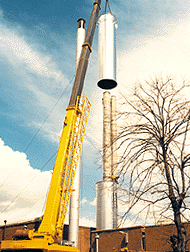
| Britania Group operates to the highest Health & Safety standards across all of its projects. High level access projects including inspection and operations on Single Flue Industrial Steel Chimneys are carried out in accordance with the Health & Safety Executive (HSE) GS53 and guidance from the Association of Technical Lightning & Access Specialists (ATLAS).  Particular attention is needed for the safe operation of single flue steel chimneys which are highlighted by the HSE and ATLAS. Single-flue chimneys rely on the structural integrity of the flue for their stability. They are vulnerable structures because the flues vent agents, which cause rapid deterioration of steel. In addition, they are dynamically sensitive and complex structures. They are different from conventional structures because they respond to cyclic components of everyday loads, especially wind. If the frequency of the cyclic component is within 10% of one of the chimney’s own natural frequencies, this response is magnified, sometimes with catastrophic results. | This susceptibility to cyclic loading means that the design of a chimney is a specialist process. It requires the provision of sufficient material to ensure structural integrity, which needs to be balanced by the material requirements for desirable dynamic behaviour. If a chimney is to behave in the way that the designer wants it to, its shell thickness must be maintained above a specific minimum. Appearances may deceive Current insulation methods, which use corrosion resistant casings, cover the flue and give a false impression of its condition. Quite often, the shiny exterior of the casing for the insulation can hide a badly corroded shell. While current design requirements ensure that steel chimneys have an inherent factor of safety, some have collapsed and there is plenty of evidence of ‘just-in-time’ repairs. Consequences of a collapse The consequences of a chimney collapse could be very serious because the potential drop-zone may cover a large area sand could put people and hazardous processes at risk. Lack of regular inspection and maintenance is a major cause of dangerous deterioration in steel chimneys. The need for inspections Chimneys need inspecting because they operate in harsh conditions and deterioration of the steel shell is inevitable. The degree of damage depends on how long the process of deterioration is allowed to continue unchecked. In inadequately maintained chimneys, it may progress undetected until it is at the point which it may affect or compromise the integrity of the chimney. This may result in collapse of the chimney or require an unplanned chimney shutdown of unknown duration. For futher information visit www.hse.gov.uk and www.atlas-1.org.uk to request a copy of The ATLAS Guide to the Inspection of Single Flue Industrial Steel Chimneys. | |
Britania Group acknowledges copyright ownership of the above extracts from HSE Guidance Notes GS53 | ||